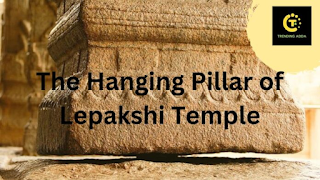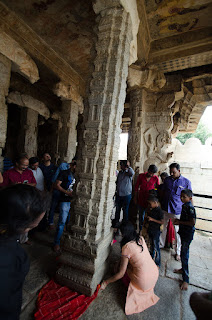The Hanging Pillar of Lepakshi Temple: A Marvel of Architecture
Lepakshi Temple, located in the southern state of Andhra Pradesh, India, is renowned for its stunning architecture and intricate carvings that showcase the rich cultural heritage of the region. Among its many architectural wonders, the Hanging Pillar of Lepakshi Temple stands out as a true marvel and a testament to the engineering and artistic skills of ancient India.
The Lepakshi Temple Complex
Before we delve into the fascinating story of the Hanging Pillar, it's essential to understand the significance of Lepakshi Temple. This temple complex is dedicated to Lord Veerabhadra, a fierce incarnation of Lord Shiva, and it dates back to the 16th century during the Vijayanagara Empire's reign.
The Lepakshi Temple complex is known for its grand architecture, intricate sculptures, and vibrant frescoes that depict various mythological stories and events. It has three main shrines, each dedicated to a different deity, making it a significant pilgrimage site for devotees and a treasure trove of history and art for enthusiasts.
The Mystery of the Hanging Pillar
The Hanging Pillar of Lepakshi Temple is located in the main hall of the temple, known as the Natya Mantapa or the Dance Hall. What makes this pillar truly remarkable is its unique architectural anomaly—it appears to be hanging from the ceiling without any support from the ground. This peculiarity has baffled visitors, architects, and engineers for centuries.
Architectural Marvel
The pillar is made of a single large block of granite and stands approximately 15 feet tall. It has a circular base, and its top connects to the ceiling. Remarkably, you can pass a thin piece of cloth or paper beneath the pillar, highlighting that it is not in contact with the ground. This engineering marvel is a testament to the advanced architectural techniques of the Vijayanagara era.
Legends and Myths
As with many ancient architectural wonders, the Hanging Pillar of Lepakshi Temple has its fair share of legends and myths. According to local folklore, the pillar was intentionally left hanging to prove the superior craftsmanship of the artisans. However, this is more of a legend than a historical fact.
Scientific Explanation
While myths and legends add to the mystique of the Hanging Pillar, there is a scientific explanation for its peculiar construction. The pillar is not entirely detached from the ground; rather, it has a small point of contact. This point is often obscured by offerings and vermilion applied by devotees.
The Hanging Pillar's engineering brilliance lies in its distribution of weight and balance, allowing it to give the illusion of being unsupported. While it may not defy the laws of physics, it is a testament to the remarkable skill and knowledge of the architects and engineers of the Vijayanagara Empire.
Preserving the Legacy
Today, the Hanging Pillar of Lepakshi Temple continues to draw tourists, historians, and architects from around the world. The temple complex, as a whole, is a protected heritage site, and efforts are made to preserve and restore its architectural treasures.
Visiting the Lepakshi Temple and witnessing the Hanging Pillar is not only an opportunity to marvel at ancient craftsmanship but also a chance to connect with the rich cultural and historical heritage of India. It stands as a symbol of human ingenuity and the enduring legacy of a bygone era.
In conclusion, the Hanging Pillar of Lepakshi Temple is a captivating blend of art, architecture, and mystery. It reminds us of the incredible achievements of our ancestors and the enduring allure of ancient wonders that continue to amaze and inspire us today.




Comments
Post a Comment